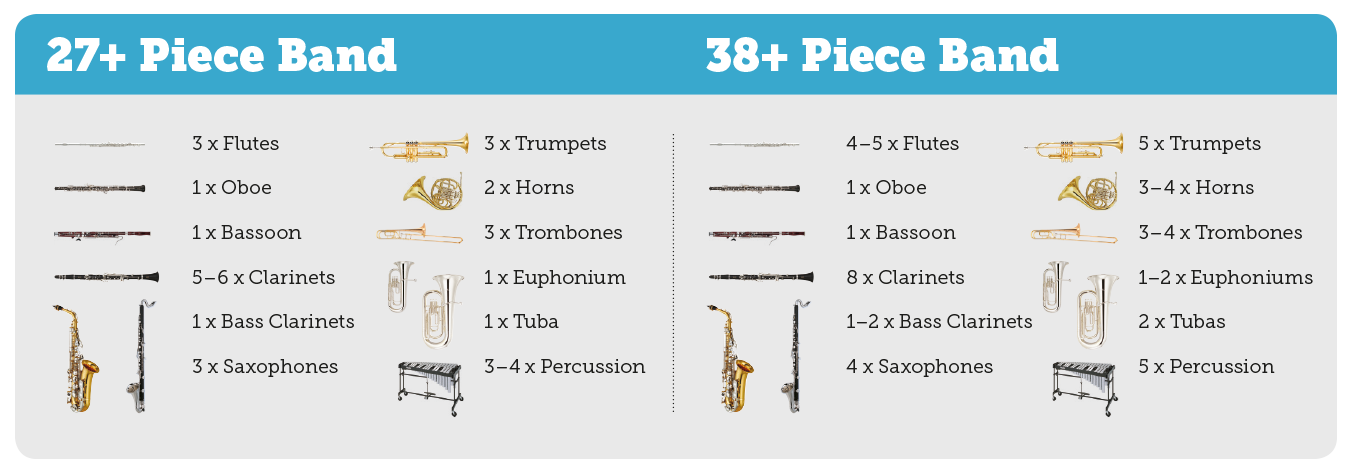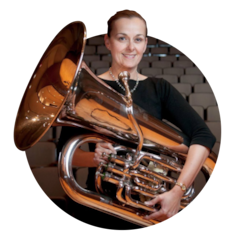The Ins and Outs Of Instrumental Recruitment
The Ins and Outs Of Instrumental Recruitment

How you can achieve a more balanced instrumentation
Balanced instrumentation is essential for optimum educational outcomes. It allows for the best possible sound and ability to play any appropriate repertoire, both of which provide the most satisfying experience for players, conductor ,and audience. Instrumentation that is not balanced in the recruiting stages leads to oversupply of the more popular instruments, resulting in limited opportunities for those players in the future. The following tips aim to provide guidance in proactively controlling the recruiting process in order to end up with a balanced ensemble.
Working towards optimum instrumentation
It is an easy trap to recruit based on the instruments available in your institution, rather than working towards an optimum instrumentation. If you don’t already own sufficient numbers of key instruments such as viola, cello, double bass (strings) or bass clarinet, baritone sax, horn, euphonium and tuba (concert band), you need to have a plan to acquire them over time. Depending on budgeting restrictions, this acquisition process may need to be planned over a relatively long period. Having good instrumentation requires financial support. It should be self-evident that it is important to have your school administration and music parents on board with your view about good instrumentation. Effective advocacy for the importance of balance is a vital aspect of successful recruiting.
Some programs own all the instruments for first year learners. Students who own their own instrument tend to show much greater commitment. Many programs require students on flute, clarinet, alto and tenor saxophone, trumpet, and trombone to purchase their own instrument from the very beginning. Other programs require student acquisition of these instruments after the first year. It is typical for more expensive instruments such as bass clarinet, baritone saxophone, bassoon, horn, euphonium, and tuba to be provided by the school. And then there are programs that start with a more limited instrumentation with an aim to switch students to other instruments in subsequent years. In strings, for example, switching to viola from violin, and to double bass from cello is common. In the winds other common switches include clarinet, sax or flute to double reed (oboe, bassoon); alto or tenor sax to baritone sax, clarinet to bass clarinet; and trumpet, trombone to horn, euphonium or tuba. In some cases programs require intending saxophone players to start on clarinet and intending percussionists to have a piano background. Many possible scenarios can be effective with a carefully managed plan that reflects your philosophy.
What constitutes balanced instrumentation?
The following numbers are a suggested guide to balanced concert band instrumentation, given two approximate starting group sizes. If you start with limited instrumentation then you should end up with similar instrumentation to these examples after “switching”. For example, start extra clarinets that will switch to double reeds.
It’s worth noting that the biggest single section in concert band instrumentation should be the clarinets. Many school concert bands have some, or all, of their flute, saxophone, trumpet, and percussion sections with more numbers than the clarinet section. This inherently creates balance issues. Extra clarinets are rarely a problem so err on the side of that section being bigger rather than the others.

All about the bass
There is no doubt that the tuba is the best option for a bass instrument in the concert band, and the string bass for the string orchestra. In both cases smaller versions of these instruments are available to accommodate younger students. Given the prevalence of electric bass in some school ensemble programs, it seems there is a belief that this instrument is an effective substitute for acoustic instruments in concert ensembles.
While the inclusion of an electric bass may sometimes be appropriate in particular styles, on its own it is not the best proxy for tuba in concert band, or string bass in orchestra. This is best achieved with a synthesised keyboard bass that is capable of emulating the acoustic instrument in question. One of the vital distinctions is the ability to sustain a note indefinitely and play appropriate dynamics and articulation.
This volume and articulation control can be via a dial or slider on the keyboard or a foot pedal you can connect. Suitable keyboards are readily available across many brands and are very cost effective. The Yamaha PSR-E453 is a great example of a keyboard that will work well. Using keyboard bass has the added potential of engaging a student with even a limited keyboard background who may not have been attracted to one of the other ensemble instruments.
A digital piano is only a useable substitute if it has a “voice” (tone setting) that emulates a sustaining tuba sound. Piano-type tone settings typically decay and lack the ability to adjust volume continuously. The desired tone is as close to the acoustic instrument as possible - either a voice on the keyboard that lists as tuba or a horn patch played in lower octaves can also work well. Even if you have tuba and/or double bass, directors should consider the keyboard bass as an excellent supplement to the acoustic instruments in order that the bass sonority can be fully and effectively realised without sounding forced.
Similarly, reed bass instruments (bass clarinet, baritone sax, bassoon) do not make up for a lack of tuba or string bass and may result in those instruments feeling forced to play too loud, with less than characteristic tone, to try and compensate. Reed bass instruments also lack the breadth of tone that provides warmth to the desired ensemble sonority. Another advantage of the keyboard bass is pitch stability at the foundation of the ensemble; this can be a real boon to working on intonation.
Strategies to level the playing field
You will need to employ a variety of strategies to optimise your chances of obtaining balanced instrumentation. Never underestimate the value of one-on-one discussions with parents and students to help guide instrument preference.
1. Establish quotas
At recruiting meetings and events you should clearly state to parents and students the maximum number of students that can take up each instrument. These quotas will typically reflect the total anticipated number of beginning recruits. It is important that you explain to all stakeholders - including school administrations - the vital importance of balanced instrumentation to a successful program. You need to do whatever it takes to get adequate numbers of students to play the “less popular” instruments. It is usually necessary to ensure students provide multiple preferences (typically three) for instrument choice to allow the teacher some flexibility in achieving optimum balance. Some programs encourage diversity in these choices (e.g. one woodwind, one brass).
3. Remember, some instruments are “special”
Frame your recruiting process so that learning one of the less popular instruments is described as a “special privilege” reserved for the top students. It can also help to emphasise that playing less popular instruments will ensure future opportunities for those students in the form of scholarships, greater ensemble opportunities and so on. Another related strategy is to provide financial incentives for playing these instruments by reducing or removing instrument hire fees and special lesson rates.
2. Do your homework
Another proven strategy is to gather information on your potential recruits. This could include discussions with teachers about student behaviour, personality, work habits, perseverance, family support, etc. Many programs also get data from aptitude tests like the freely available Selmer Music Guidance Survey, and other available tests such as the Gordon Instrument Timbre Preference Test. Armed with this information, the goal is to target students with the preferred personality dispositions and aptitudes, and strongly encourage them to take up a significantly larger proportion of the instruments that are more difficult to recruit. This ensures that you have a much better chance of keeping these instruments in the cohort as it goes forward. This is predicated on the notion that your strongest recruits are most likely to be successful and continue.
4. Take popular instruments out of the limelight
If you are going to have instrument demonstrations so that students and parents know what their instrument options are, be sure that demonstrations of the less popular instruments are the most impressive, and consider making the sax, flute, drums and other popular instruments, less so. This helps make up for the inherent bias in student knowledge and notions of which instruments are “cool”. It could work to have the jazzy, highly appealing demo pieces on the instruments that need the promotion and less exciting examples on those that need less promotion. Also consider which students demonstrate which instruments. More “popular” students on the less popular instruments can help. If you are lacking appropriate student demonstrators consider guest artists or YouTube clips.
If you are going to do “blow-testing” - where students try out instruments - consider proactively managing the process. For example: harder reeds on sax than clarinet, and newer instruments for those being more heavily promoted. Work the process to maximise your balance!
5. Recognise gender stereotypes and aim to debunk them
Students and parents tend to think brass and percussion instruments are predominantly masculine (especially trumpet, trombone, tuba), and woodwind instruments are predominantly feminine (with the exception of saxophone). You can help to debunk these stereotypes by carefully choosing which genders demonstrate which instruments.
6. Stick with it
It’s important to remember that your recruiting may not be optimum every year. If you keep your eye on the goal of balanced instrumentation at every opportunity, and make it a top priority, it will usually work out over the longer term. Switching instruments with more experienced students can also make improvements, even at later stages in a program. Don’t give up or get discouraged, the benefit of a balanced instrumentation for all involved is well worth the effort.
WORDS BY: Dr. Rob McWilliams, Dr. Heather McWilliams

WORDS BY: Dr. Rob McWilliams, Dr. Heather McWilliams
Rob McWilliams, Ph. D., has worked in instrumental music education and ensemble direction at secondary and tertiary levels in Australia and the USA for more than 30 years. He is currently the Education Outreach Clinician for Yamaha Music Australia.

Heather McWilliams earned a Ph. D. in Curriculum & Instruction (Music Education) from the University of Wisconsin — Madison in 2003, before teaching tuba, euphonium, band, and music education courses at American universities for more than a decade. She has taught instrumental music in Queensland and Western Australia. Heather currently works for Education Queensland. She is also a freelance conductor and clinician.
